By Markéta Dolejšová, Jaz Hee-jeong Choi, and Chewie
(contact: marketa.dolejsova@aalto.fi)
Poster presented at the Society of Artistic Research – 15th International Conference on Artistic Research – 2024.
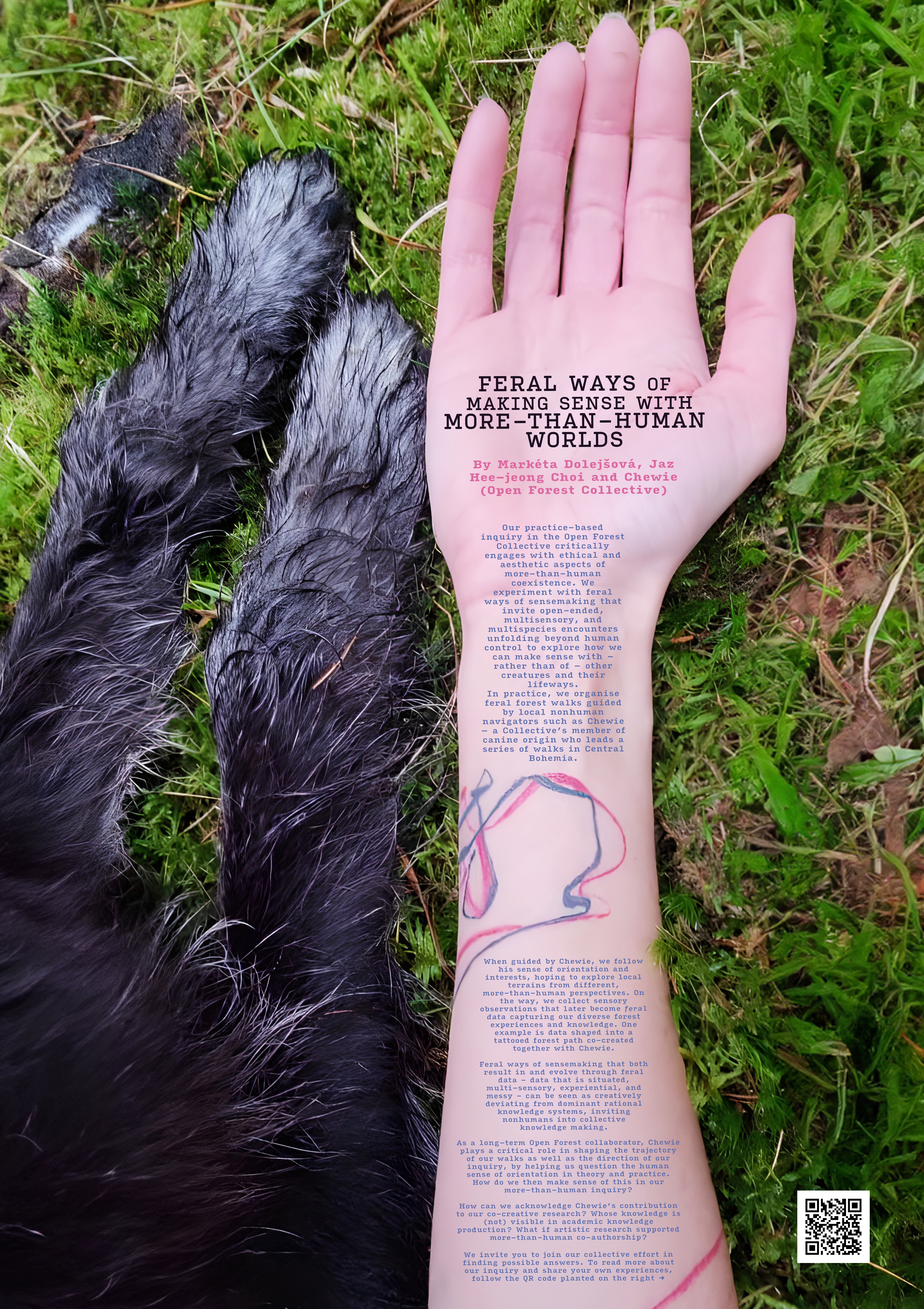
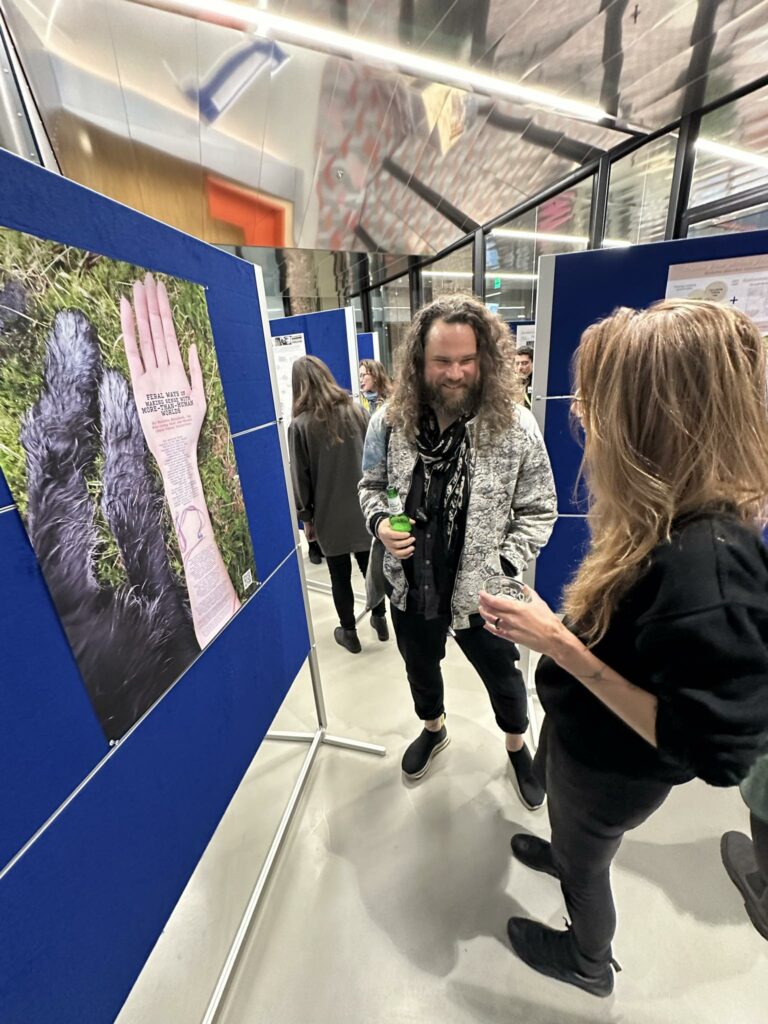
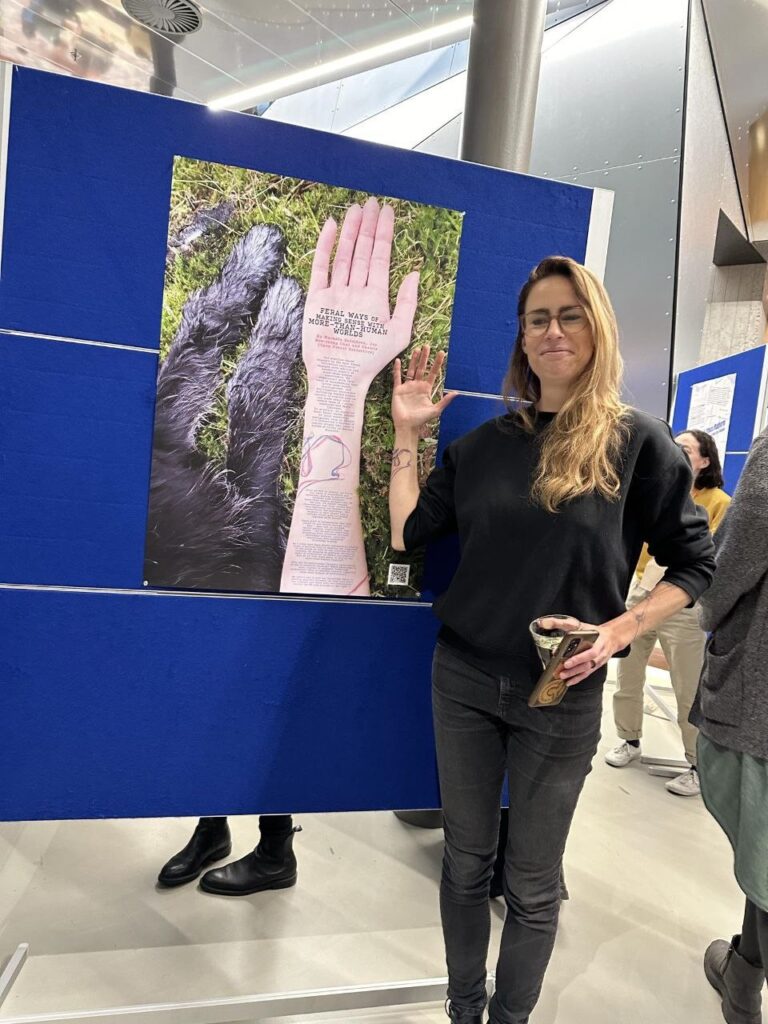
At the centre of the Open Forest Collective’s practice-based inquiry is our common interest in the more-than-human – to recognise the relations that bring to life humans and nonhumans, including other species and technologies, and seek new ways for coexistence. With the growing awareness of the detrimental effect of anthropocentrism in the dominant Western canon, as manifested in the global and planetary crises of the past and present, more people acknowledge and seek alternative ways of knowing, doing, and living together.
This interest has been growing substantially across various fields of research and practice, including art (Boyd et al., 2015; Dolejšová et al., 2023; 2024; Keski-Korsu 2023; Sachs Olsen, 2022). The evocative potential of art has been recognized for developing new social, aesthetic, and ethical relations with multispecies nature (Boyd, 2015) as well as algorithmic agencies, for instance in AI media synthesis (Choi et al., 2020; Hámošová & Rusnák, 2023). New approaches to artistic research and practice such as multispecies art and generative or synthetic media art that have emerged in recent years mark a shift from using art to highlight environmental or socio-technical concerns towards participatory, co-creative works that engage nonhuman entities as partners in knowledge-making. Artistic experiments with more-than-human (MtH) co-creation – of knowledge, data, experiences, and relations – are thus well situated to challenge the anthropocentric myth of human exceptionalism and foster a shift from ‘making sense of’ to what Haraway (2016) calls ‘making sense with’ diverse nonhuman creatures and entities inhabiting our worlds.
More-than-human co-creation
The term ‘co‐creation’ refers to a wide array of collaborative activities engaging participants at various stages of knowledge-making processes (Wilson, 2009). By MtH co-creation, we broadly refer to the idea that humans and nonhumans are intertwined in shared worlds, which they help to shape through their distinct lifeways.
While recent years have seen a rising number of MtH co-creation inquiries, many aspects of how to generate knowledge, grow relations, and make sense with nonhuman creatures remain contentious. Challenges often relate to the inherent indeterminacy in the co-creative process, where inquiries often necessarily unfold beyond the agendas and expectations of human researchers and practitioners. This indeterminacy, or ‘feralness’ (Tsing et al., 2020) of MtH collaborations requires a constant (re)negotiation of the agential relations and power dynamics among all participants involved in the co-creative process. Issues regarding the uneven distribution of power, control, and agency in MtH collaborations – how human and nonhuman contributors make choices and decide about their actions – have been of concern in creative MtH inquiries across multiple disciplines including art, design, architecture, and urban planning as well as anthropology and geography (Bastian et al., 2017; Choi et al. 2023; Dolejšová et al., 2024; Keski-Korsu, 2023; Sachs Olsen, 2022).
Feral ways of sensemaking
In Open Forest Collective, we engage with MtH co-creation and the above issues through ‘feral ways’ of sensemaking that invite open-ended, multisensory, and multispecies encounters unfolding beyond human control. These encounters can take the form of, for instance, experimental walks guided by local human and nonhuman navigators (figure 1) or drifts (dérives) where participants move through space and time guided by (co-)generated prompts (Dolejšová et al. 2023; Dolejšová et al. 2023a).
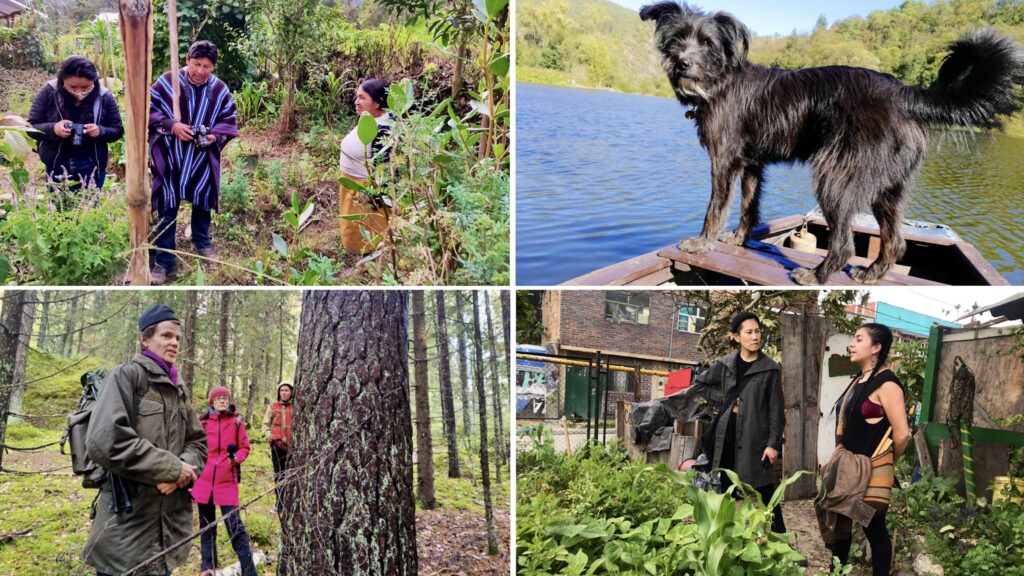
In this text, we will focus primarily on the forest walks and the relational practice of ‘walking-with’ that is embraced as a way of becoming more responsive to a place, and a convivial activity stimulating thinking, feeling, and participation that can trigger co-creative knowledge production (Springgay & Truman, 2017; Dolejšová et al., 2023). We will discuss our experiences from an ongoing series of walks with the protected forest area Křivoklátsko in Central Bohemia that has been led by Chewie – a Collective’s member of canine origin who has lived in Křivoklátsko for more than a decade (figure 2).
Walking-with forests
The Open Forest walks invite participants to pay attention to their surroundings, explore local ecologies, collect sensory impressions, and share them as stories that can be uploaded to an online Feral map (Choi et al., 2024). The forest stories and experiences collected from the walks aim to offer diversely situated perspectives on what MtH ecosystems such as forests might mean and to whom.
The Bohemian walks guided by Chewie, who holds extensive sensorial knowledge of the local forest landscape, provide an opportunity to explore local forests while following the interests of a nonhuman creature. During the walks Chewie’s sense of orientation defines what is worth exploring and his sensory capacities become key. Human senses are present but their usual connection to rational decision-making is put on hold. This feral walking helps to facilitate a temporary shifting of roles and agential relations among the human and nonhuman participants (e.g., who guides, who follows).
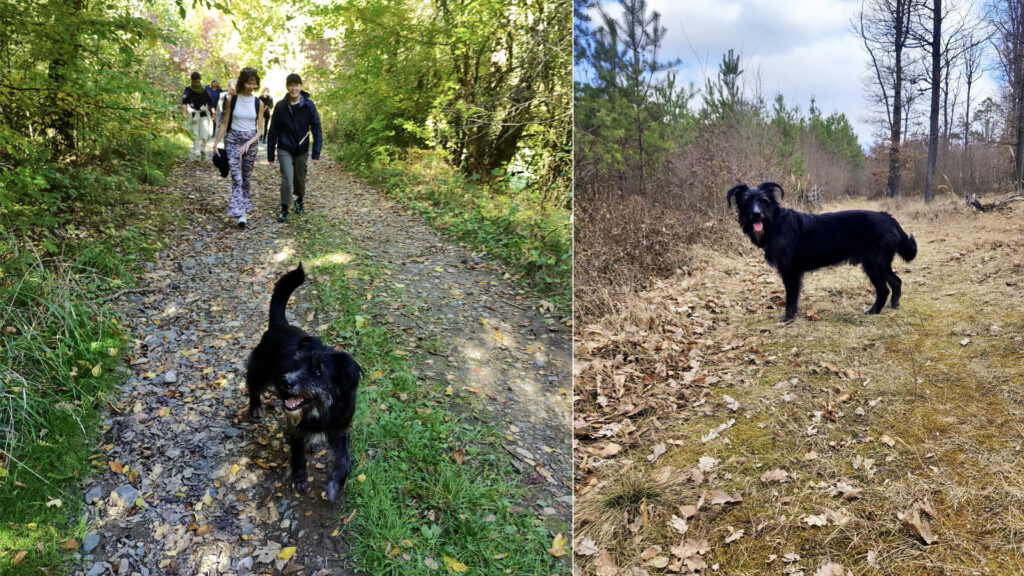
When guided by Chewie, we have walked into forest spaces and situations that we might never discover otherwise and engaged in new (at least to us) forest rituals such as ‘Moss Spa’ – plunging our faces into a moss, to explore the forest from different perspectives (figure 3).
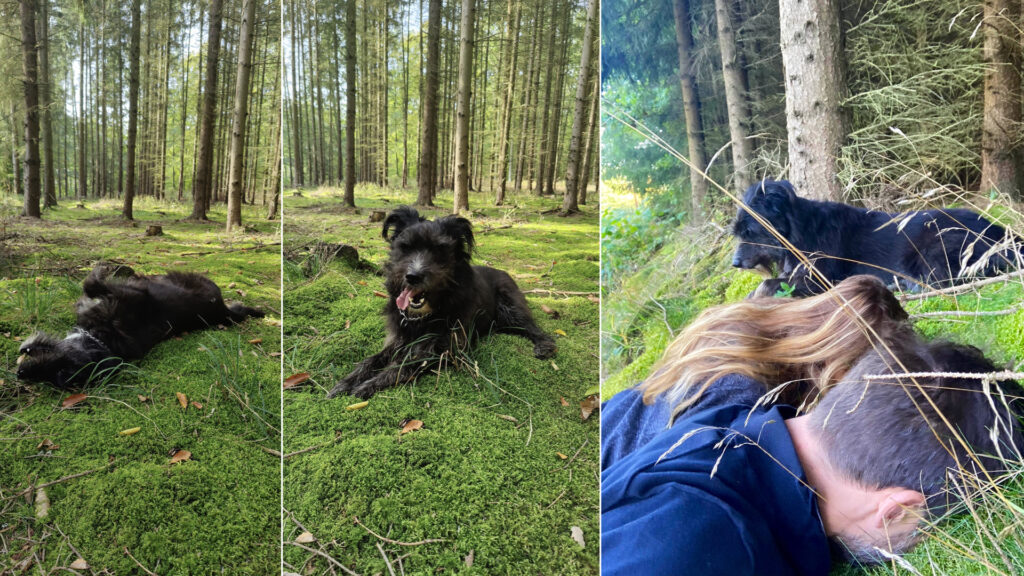
These experiences expand embodied knowledge of the forest and its different temporalities, as captured, for example, in the Bohemian forest stories shared via Feral Map (figure 4). Along with this MtH guidance, the project explores what we can learn as humans if we surrender our control over daily movements through time and space, and, instead, attune to the rhythm and interests of surrounding creatures.
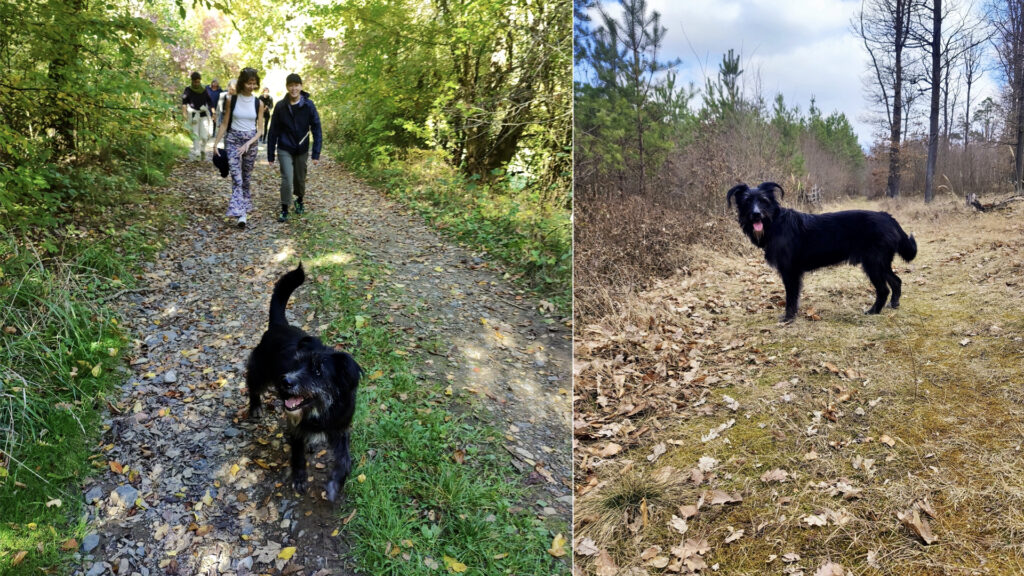
Feral data
In the Open Forest project, forest stories and experiences emerging from the walks are considered as a type of data capturing diversely situated knowledge of the human and nonhuman walkers: data that is co-created, qualitative, experiential, eclectic, and messy – or, feral (we borrow the term ‘feral data’ from Australian anthropologist Genevieve Bell, 2018). Examples of feral data collected so far include data woven into traditional belts and provoked by tree sensors (Dolejšová et al., 2023), data turned into a memory seed bank, a multispecies ritual, and a wayfinding game (Dolejšová et al., 2023a) as well as data shaped into a tattooed forest path co-created together with Chewie (figure 5). Our continued engagement with feral data emerging from the walks with multispecies ecologies, such as those in the Křivoklátsko forest led under the Chewie’s guidance, helps us reflect on diverse more-than-human experiences, epistemologies, and cultures (Dolejšová et al., 2023a; Choi et al., 2024).
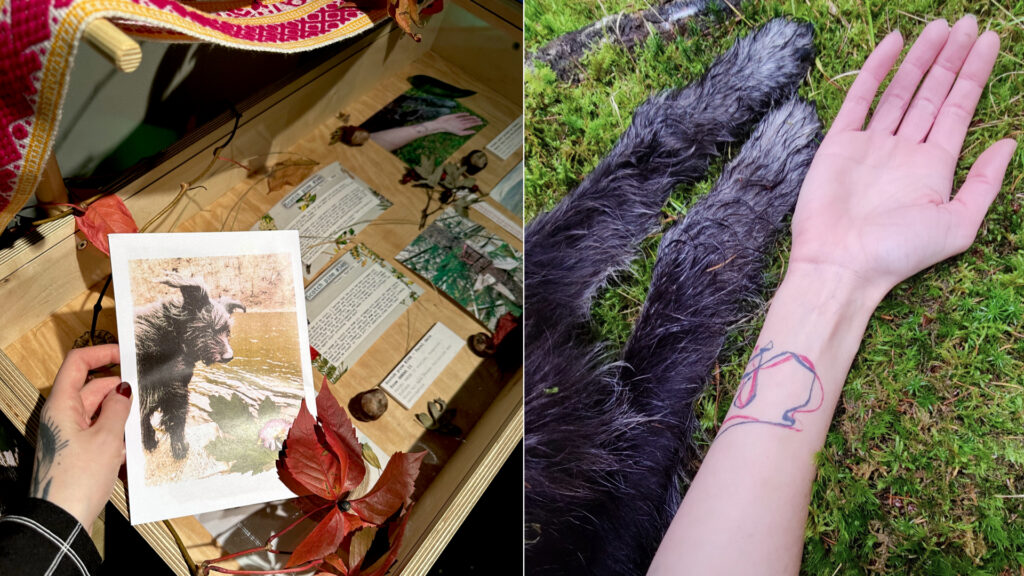
Whose knowledge, whose interests?
The walking guides play a critical role in shaping the trajectory of our collective movement through space and time, and what we may pay attention to during the walks. As a long-term Open Forest collaborator guiding numerous walks, Chewie’s contributions have also shaped the direction of our practice-based inquiry, particularly by helping us continue to question the human sense of orientation in theory and practice, experimentally and experientially. How do we then make sense of this in practice in our more-than-human inquiry, especially when it comes to research outcomes and outputs?
Throughout our research practice, inspired by many others who have done this work earlier – for instance in many Indigenous and non-Anglo-European cultures – we have been asking ourselves what it actually means to do more-than-human co-creation:
How can we, as human researchers and practitioners, think and collaborate with nonhumans? How can we (and should we even) learn to think the world through another’s perspectives? How can we learn from each other in a mutual way, beyond the unidirectional mode of humans observing other creatures? How do we reach beyond representational modes of including other-than-humans’ experiences and interests?
One of the ways we are trying to properly acknowledge Chewie’s contribution has been to include him as a co-author in some of our research publications (e.g., Dolejšová et al., 2023a, 2023b, 2023c, 2024). For us, Chewie’s contribution has been critical to the Open Forest inquiry – not as the object of the study, but as an active collaborator shaping the research approach, data collection, and outcomes, clearly deserving of acknowledgement as a co-author for some of our research outputs. We are certainly not the first ones to experiment with more-than-human co-authorship in academic research. Attempts to include nonhumans as research co-authors have happened across disciplines involving a range of creatures from cats (Hetherington & Willard, 1975) to apes (Savage‐Rumbaugh et al., 2007) bringing “the academic community to an uncomfortable edge” (Bradshaw, 2010: 27):
“Nonhuman animals and their indigene human neighbours have been denied participation in shaping policies that affect their lives. Recognition of human-animal mental and moral continuity, now including language, deconstructs this hierarchical imperative by directly linking questions of wildlife disenfranchisement and the present socio-ecological crisis to the agenda of a specific human culture and agenda” (Bradshaw, 2010: 27).
Following Chewie’s forest guidance as part of our practice-based research requires more than going on a walk together but also a genuine endeavour to form a mutual understanding that involves, for instance, attending to each other’s languages through movements, gestures, facial, and body expressions. We sense different meanings at different times of “woof, woof, woof” coming from Chewie. Yet we continue to learn through our own different ways of relating with Chewie, his different relations with the forest and us. In turn, we learn how we might better attune to diverse MtH relations that make the worlds we live-with, and how to make sense of what may be possible in moving towards futures that are liveable – for humans as well as nonhumans.
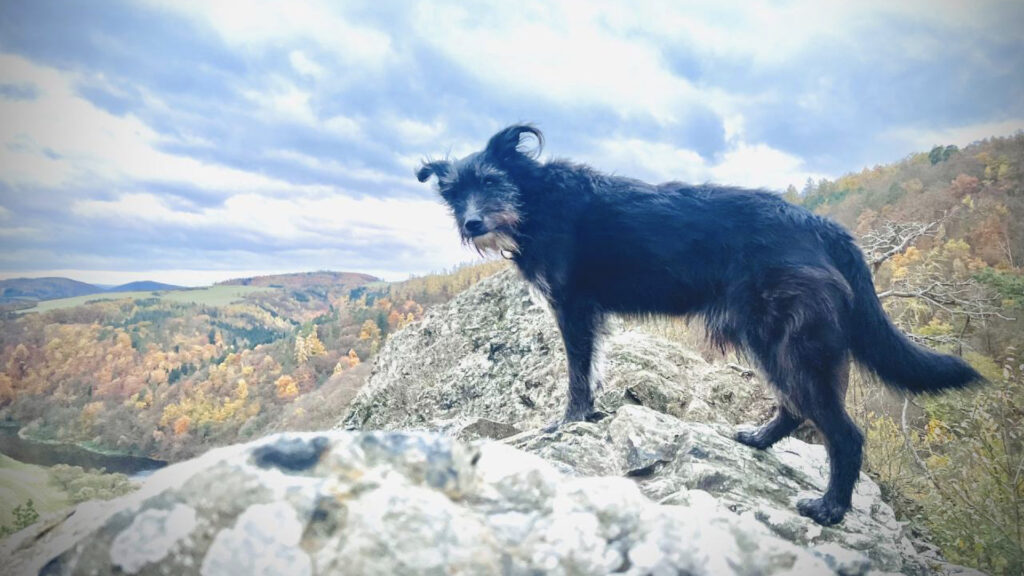
References
Albert, T. and Wager, E. (2023). How to handle authorship disputes: a guide for new researchers. Science Editor and Publisher, 7(2), 238-242.
Bastian, M., O. Jones, N. Moore, and E. Roe. 2017. Participatory Research in More-Than-Human Worlds. London: Taylor & Francis.
Bell, G. (2018). Making life: a brief history of human-robot interaction. Consumption Markets & Culture, 21(1), 22-41.
Bradshaw, G. A. (2010). An ape among many: Animal co-authorship and trans-species epistemic authority. Configurations, 18(1), 15-30.
Boyd, M. (2015). Multispecies becomings in the Anthropocene. Antennae: The Journal of Nature in Visual Culture, 31, 5–8.
Choi, J. H. J., Braybrooke, K., & Forlano, L. (2023). Care-full co-curation: critical urban placemaking for more-than-human futures. City, 27(1-2), 15-38.
Choi, J.H-j., Botero, A., Dolejšová, M. & Sleigh, L. (2024 – forthcoming). Messy, Entangled, and Shapeshifting: Feral Mapping. International Journal of Cartography – Special Issue on Art & Cartography.
Choi, J.H-j., Forlano, L., & Kera, D. (2020). Situated Automation:Algorithmic Creatures in Participatory Design. Proceedings of the 16th Participatory Design Conference 2020 – Participation(s) Otherwise – Volume 2, Manizales, Colombia.
Dolejšová, M., Botero, A., and Choi, J.H.-j. (2023). Open Forest: Walking-with Feral Stories, Creatures, Data. In: Proceedings of the 21st European Conference on Computer-Supported Cooperative Work. The International Venue on Practice-centered Computing on the Design of Cooperation Technologies. https://dl.eusset.eu/handle/20.500.12015/4676
Dolejšová, M., Choi, J., Botero, A. & Chewie (2023a). Feral Drifting with Lonja Wetlands: Fragments of More-than-Human Cohabitation. Designing in Coexistence – Reflections on Systemic Change. Ed by Mitrović, I., Roth, M., Čerina, T. Croatian Architects’ Association, ISBN: 978-953-6646-31-9.
Dolejšová, M., Botero, A, Choi, J.H-j. and Chewie. (2023b). Open Forest. In CreaTures Co-Laboratory Catalogue, p. 72-79. Edited by Markéta Dolejšová. DOI: https://doi.org/10.5281/zenodo.7525506
Dolejšová, M., Botero, A., Choi, J.H.-j. and Chewie (2023c). Reimagining forest relationships through walking and forest stories (abstract). Sustainability Science Days 2023, University of Helsinki
Dolejšová, M., Botero, A., Choi, H-j. J., Mitro, M., Pokrywka, A., Mattelmäki, T. and Chewie, Š. (2024). Feral Experiments in CreaTures Co-Laboratory. Research in Arts and Education, 2024(1), 25–40.
https://doi.org/10.54916/rae.142583
Haraway, D. (2016). ‘Situated Knowledges: The Science Question in Feminism and the Privilege of Partial Perspective’. In Space, gender, knowledge: Feminist readings (pp. 53-72). Routledge.
Hetherington, J. H. and Willard, F. D. C. (1975). Two-, Three-, and Four-Atom Exchange Effects in bcc ³He. Physical Review Letters, 35 (21): 1442–1444, doi:10.1103/PhysRevLett.35.1442
Keski-Korsu, M. (2023). Garden of Agency. In: Exercises in Togetherness, Suonyrjö, E. (ed.), New York: The Finnish Cultural Institute in New York. p. 32-35 4 p.
Sachs Olsen, C. (2022). Co‐creation beyond humans: The arts of multispecies placemaking. Urban Planning (ISSN: 2183–7635) 2022, Volume 7, Issue 3, Pages 315–325 https://doi.org/10.17645/up.v7i3.5288
Savage‐Rumbaugh S., Wamba K., Wamba P., and Wamba N. (2007). Welfare of apes in captive environments: comments on, and by, a specific group of apes. J Appl Anim Welf Sci 10: 7–19. DOI:10.1080/10888700701277261
Springgay, S., & Truman, S. E. (2017). Walking methodologies in a more-than-human world: WalkingLab. Routledge.
Tsing, A. L., Deger, J., Keleman, A. S., and Zhou, F. (2020). Feral Atlas: The More-Than-Human Anthropocene. Stanford: Stanford University Press. http://doi.org/10.21627/2020fa
Wilson, L. (2009). Collaboration in the Service of Knowledge Co-Creation for Environmental Outcomes, Science and Public Policy. In Handbook of Research on Electronic Collaboration and Organizational Synergy (pp. 599-614). IGI Global